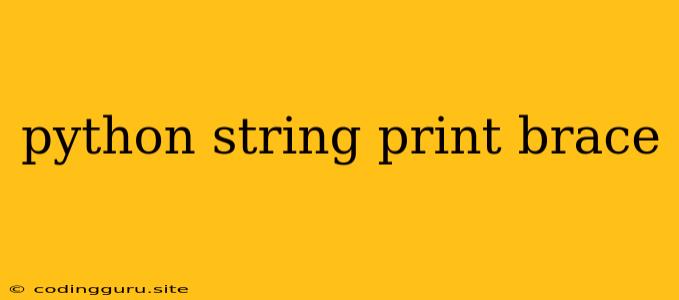Working with Strings and Braces in Python: A Comprehensive Guide
Python is a versatile language renowned for its readability and simplicity. Working with strings is a fundamental aspect of programming, and often, we need to format them to present information in a clear and organized manner. Braces, specifically curly braces ({}), play a crucial role in this process. Let's delve into the world of Python strings and explore the various ways we can use braces for effective string formatting.
Why Do We Need Braces in Python Strings?
Imagine you have a variable storing a user's name, and you want to display a personalized message. Braces provide a powerful mechanism for dynamically inserting values into strings, making them incredibly useful for creating dynamic and informative outputs.
The Power of format() Method
The format() method offers a clean and efficient way to incorporate variables into strings. Here's how it works:
name = "Alice"
message = "Hello, {}! Welcome to the world of Python.".format(name)
print(message)
Output:
Hello, Alice! Welcome to the world of Python.
In this code, the curly braces act as placeholders. The format() method takes the variable name and inserts it into the string at the position of the braces.
Using Positional Arguments
You can utilize multiple placeholders in your string and control the order of insertion using positional arguments:
name = "Bob"
age = 30
message = "My name is {}, and I am {} years old.".format(name, age)
print(message)
Output:
My name is Bob, and I am 30 years old.
Utilizing Keyword Arguments
For even more clarity and readability, you can use keyword arguments within the format() method.
name = "Charlie"
age = 25
message = "My name is {name}, and I am {age} years old.".format(name=name, age=age)
print(message)
Output:
My name is Charlie, and I am 25 years old.
Beyond Simple Placeholders: Formatting Options
The format() method offers several powerful formatting options to customize your output:
-
Padding: You can add spaces or characters to the left or right of a variable using the
:symbol followed by a number and the character:number = 123 formatted_number = "The number is: {:>10}".format(number) print(formatted_number)Output:
The number is: 123 -
Alignment: You can align text to the left, right, or center:
text = "Python" left_aligned = "{:<10}".format(text) right_aligned = "{:>10}".format(text) center_aligned = "{:^10}".format(text) print(left_aligned, right_aligned, center_aligned)Output:
Python Python Python -
Precision: For floating-point numbers, you can control the number of decimal places:
price = 12.999 formatted_price = "{:.2f}".format(price) print(formatted_price)Output:
12.99
F-Strings: A More Concise Approach
Introduced in Python 3.6, f-strings provide a streamlined and elegant way to format strings. The syntax is straightforward:
name = "David"
age = 28
message = f"My name is {name}, and I am {age} years old."
print(message)
Output:
My name is David, and I am 28 years old.
F-strings are generally preferred due to their conciseness and readability.
Handling Complex Data Structures
You can easily format elements within lists, tuples, and dictionaries:
person = {"name": "Emily", "age": 22}
message = f"Name: {person['name']}, Age: {person['age']}"
print(message)
Output:
Name: Emily, Age: 22
Example: A Simple Report
Let's create a small program that generates a report using string formatting techniques:
products = [
{"name": "Laptop", "price": 1200},
{"name": "Mouse", "price": 25},
{"name": "Keyboard", "price": 75}
]
print("Product Report")
print("-" * 20)
for product in products:
print(f"Name: {product['name']}, Price: ${product['price']:.2f}")
print("-" * 20)
Output:
Product Report
--------------------
Name: Laptop, Price: $1200.00
Name: Mouse, Price: $25.00
Name: Keyboard, Price: $75.00
--------------------
Conclusion
Understanding how to utilize braces in Python strings is fundamental for crafting dynamic and informative outputs. The format() method and f-strings offer flexible and powerful ways to integrate variables into strings, providing the ability to format text, align data, control precision, and even handle complex data structures. By mastering these techniques, you gain the tools to write clear, efficient, and visually appealing Python code.
